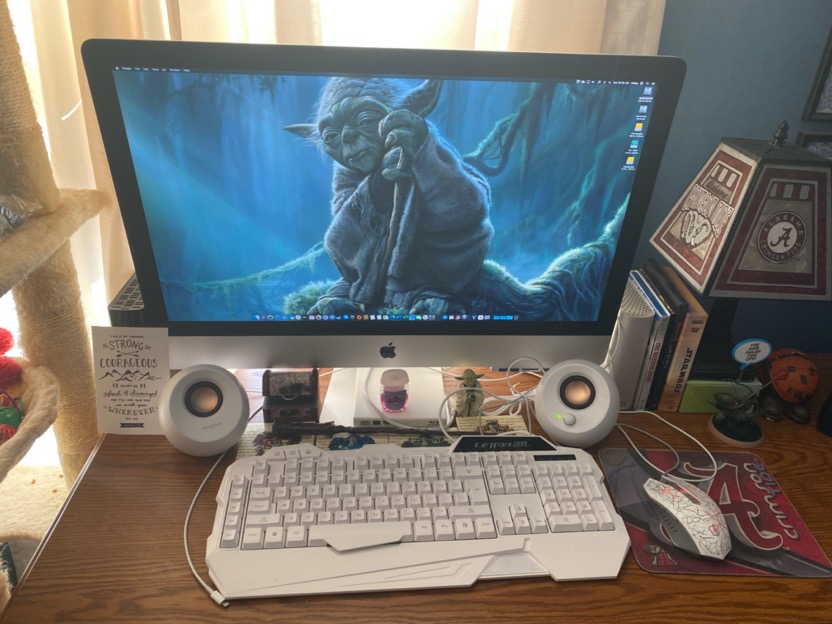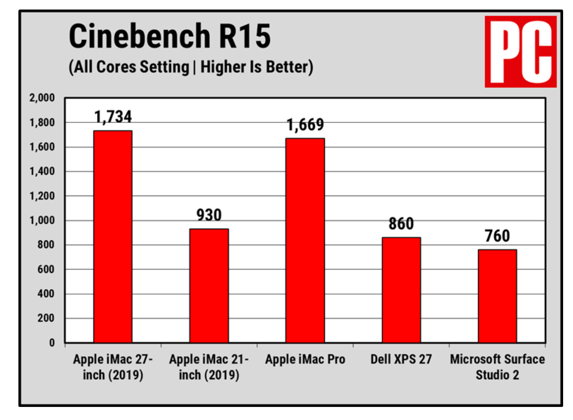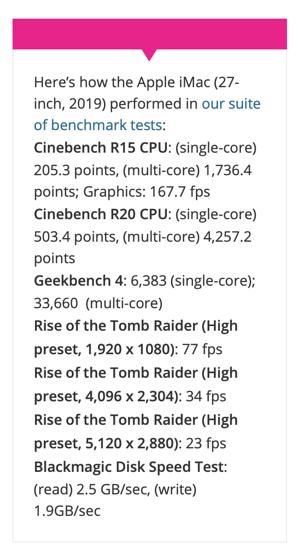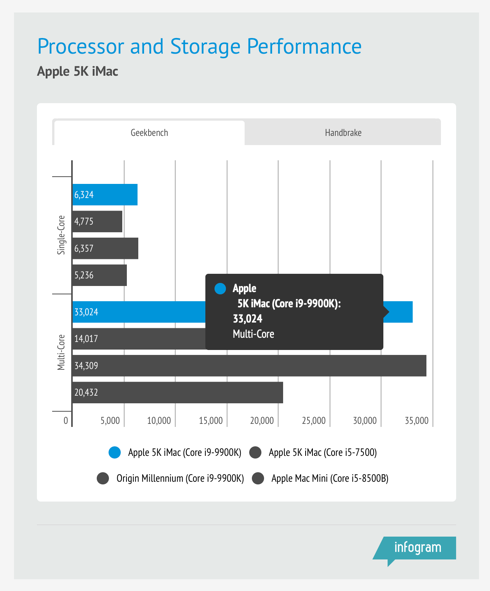
INTRODUCTION
So, I have had this machine for about 7 months now. It has been a great machine. Now, it’s time for me to do a little review. Previous to this iMac, I had a 2013 Base Model with a Core i5-4570 and a fully specced out 2012 model with a Core i7-3770 and the nVidia GeForce 680MX. So, in comparison to my previous iMacs, this one is a screamer but I did notices so differences between review units and my unit. I will explore those below.

My iMac. I am going with a white theme with this one. White keyboard/mouse and speakers. They match the blu-ray drive that I had for quite sometime now.
SPECS
27” iMac Core i5-9600k upgraded to the Core i9-9900k
CPU: Intel Core i9-9900k
RAM: 8 GB 2666MHz (upgraded to 24GB 2666MHz)
GPU: AMD Radeon Pro 580X
STORAGE: 2TB “Fusion” Drive
DISPLAY: Apple Retina 5K P3 Wide-Gamut Display
SOFTWARE: Apple macOS 10.14 Mojave (upgraded to macOS 10.15 Catalina)
THE CPU
This has to do with processor performance. I noticed in several professional reviews that my CPU seems to be underperforming in generic benchmark tests. I’d like to think that I didn’t lose the “silicon lottery” but maybe I did. Maybe there is a way to squeeze more performance out of my iMac. I am completely unsure. I am going to share some numbers and you’ll see what I mean. I have provided 2 examples with their sources fully noted.

This is the PC Mag R15 results. (Source: https://www.pcmag.com/reviews/apple-imac-27-inch-with-5k-retina-display-2019)

This is the set of results published by Tech Radar. (Source: https://www.techradar.com/reviews/apple-imac-2019-27-inch)
In CPU focused tests (Cinebench), my CPU is considerably slower than these review units. Perhaps I should not dwell on these but as a enthusiast, I can’t help to be a little disappointed in my unit. In Cinebench R15 and R20, there is considerable difference (R15: 10.5%) and (R20: 7.9%). I believe this is all due to the cooling solution that Apple has designed. In fact, I believe this design to be 8 years old. CPU power and performance is so much higher today. It could be how Apple manages the voltage in the EUFI. Whatever it is, it is hurting performance from pure hypothetical numbers as seen here.
THE GPU
My model has the base Radeon Pro 580X card with 8GB of GDDR5 RAM. Hard for me to really review this as compared to the Vega-48 in my everyday workflow. As for gaming, I have done a separate post regarding GPU performance in gaming on Windows. See that post for more details. This card performs very similar to an AMD Radeon RX570, which is a very budget gaming card. The Radeon Pro 580X is not a gaming-focused video card. It carries the “Pro” moniker for a reason. It is designed to be a card for more workstation focused tasks (3D rendering, Video encoding and exporting, etc.) so the fact that it can game is a bonus (to me).
STORAGE
The fusion drive is a great compromise, but it definitely has its drawbacks. Before I installed everything on this iMac, I considered breaking the fusion and operating as two separate drives. This way I could manually manage my drives, but now it is a bit impossible. Or at least, it would be very time consuming. This is how I manage my storage on my gaming PC.
THE DISPLAY
Fantastic, fabulous. This is my first iMac with the 5k Retina display. I am blown away with the sharpness and color reproduction. It was the first Mac I owned that that P3-Wide gamut support.

(Source: https://webkit.org/blog-files/color-gamut/comparison.html)
It can bee seen here that there is support for more colors that a typical sRGB monitor. This lead this display to be a fantastic display and supports up to 5k resolutions is the reason to own a 5k iMac (besides macOS, of course).
OVERALL PERFORMANCE
Overall performance in Geekbench seems to be fairly close. Definitely much closer than the CPU benchmarks alone. Geekbench scores reflect CPU and RAM performance.

This is the Geekbench 4 results from Digital Trends (Source: https://www.digitaltrends.com/desktop-computer-reviews/apple-imac-5k-27-inch-2019-review/)

This is Geekbench 4 and Cinebench R15 from CNET (Source. https://www.cnet.com/reviews/apple-imac-27-inch-2019-review/2/)
Now, one HUGE difference between my iMac and these 3 examples is that a) They are review units b) All of the review units Apple sent out had the Vega-48 graphics. Maybe that might explain some results… I am not sure on that. I have heard that the system runs a bit cooler overall and thus, might affect CPU performance. I am running TG Pro on my iMac so that I can control fan speeds so, I am giving my iMac maximum cooling. Yeah, Apple needs to redesign it’s cooling solution going forward. Countless PC’s build around the 9900k smoke the iMac (not just because they are overclocked, but are properly cooled). This article isn’t about comparing to PC hardware, this is about iMac to iMac.
After seeing these numbers, here are min in comparison… (Single core/Multi-Core) where possible:

In Geekbench 4, my iMac is pretty close (-3.8 difference). In Geekbench 5, it is considerable slower than the average result (-6.8% difference).
CONCLUSION
This unit is great. So many things to like. I know the design is old, but it really doesn’t bother me. The beauty is on the inside. I like aesthetics, but more than that, I like brains. This machine certainly had that. The downside is that my machine consistently underperforms based on numbers I have seen from other reviews. I went with the base 2TB Fusion drive and I don’t really regret it. About the only time that I really feel that it holds me back is booting virtual machines and BOOTCAMP. Neither of these reside on the SSD part of the fusion drive so hard drive access on these is very slow. macOS is fast and all applications open fast and without issue.
With all of that said, WWDC here in a couple of weeks may introduce newer models with faster internals, SSD standard?, a most likely a design refresh. Those are all great, but unless the performance is through the roof (and based on PC enthusiast reviews of the new 10th Gen Intel parts, they aren’t) if not better. There is no reason to upgrade from this until. Many people might upgrade and thus making many of these machines available on marketplaces. Great deal.


